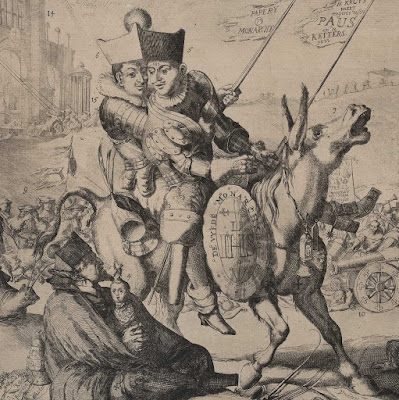(Attrib.) Romeyn de Hooghe (aka
Romeijn de Hooge; Gisling) (1645–1708)
“Arlequin sur L Hippogryphe a la
Croisade Lojoliste” (Harlequin on the Jackass leading a holy crusade), 1689, a
political broadside featuring (as extracted from the explanation offered by
Getty Images [see https://www.gettyimages.fr/detail/photo-d%27actualit%C3%A9/arlequin-sur-lhippogryphe-a-la-croisade-lojoliste-photo-dactualit%C3%A9/464757883]):
Louis XIV, as the Harlequin with a
pegged leg, is shown riding a jackass leading a holy crusade. The king wears and
shares a large biretta with James II seated behind him on the ass. Both men
wear armour and a shield bearing the monogram of the Society of Jesus hanging
from their shared saddle. Portrayed on the left in the foreground is James II’s
confessor, Father (Edward) Petre, riding a lobster and holding the infant son
of James II, James Francis (aka “The Pretender”), who wears a small windmill on
top of his head. On the left of the scene behind the jackass are the Ambassadors
of the Holy League shown riding a snail accompanied by councillors and vicars riding
on owls. Behind the jackass on the right, monks drag a cannon past a gallows,
while in the distance the ship, “Sinte Reynuyt”, departs. Also in the distance
on the left of the image, hordes of men with ropes are shown pulling down statues
from church facades. (Note: for more detail of what is depicted in this bizarre
amalgam of strange happenings, please read the description by the British
Museum further below.)
Etching and engraving with letterpress
text on fine laid paper with divisions in the sheet as published.
Size: (sheet) 53.5 x 39.5 cm; (image
borderline) 34.3 x 39 cm.
Numbered on plate ("1" to "15") within the image
borderline as keys to the legend of explanatory versesm lettered below.
Lettered in Dutch (letterpress) below
the image borderline in two lines: “Arlequin sur l['] Hypogryphe a la Croisade
Lojoliste./ Armée van de Heylige Lingue voor der Jesuiten Monarchy.”; in four
columns below the title: “Her gapen na de wint is uyt, … Monarchÿs Koppcn opstaen.”
BM Satires 1205 (Frederic George Stephens
& Mary Dorothy George 1870, “Catalogue of Political and Personal Satires in
the Department of Prints and Drawings in the British Museum”, 11 vols, London, London,
British Museum Press); Hollstein 156; Muller 1863-1882 2756 (Frederik Muller
1863, “De Nederlandsche Geschiedenis in Platen. Beredeneerde Beschrijving van
Nederlandsche Historieplaten”, Amsterdam).
The British Museum offers the following
description of this print:
“A Dutch broadside satirising Louis XIV,
James II and the Roman Catholic cause in Europe. At lower right, Cardinal
Furstenberg (1) has fallen from the back of a tortoise into the Rhine, leaving
his Cardinal's hat on the bank. Behind him, the Grand Dauphin (2) peers out of
an armoured vehicle carried on the back of a frog. In the foreground to left,
Father Petre sits cross-legged on a lobster (3); the lobster clutches in his
claws books of civil and ecclesiastical law, and a papal tiara rests on its
tail behind the rider. Father Petre, who has ass's ears, holds the infant
Prince of Wales (4), a windmill resting on his head. Louis XIV (5) in armour
with a wooden leg carries a banner reading (in translation), "Holy Crusade
against this Pope and the Heretics" and a shield lettered with Jesuit
symbols and "De Vyfde Monarchy 1688". James II (6) mounted behind him
on an ass (7) and sharing the same Jesuit cap, also fully armed, carries a
banner reading "Papery/Monarchy". The ambassador of the Holy League
follows on a snail, his hand to his head from which smoke is issuing. The ass
defecates on a group of councillors (9) who are riding owls. In the background
to the right of the ass, is a procession of musicians and monks hauling cannon
(10) led by a monk riding a pig and holding aloft a crucifix; they display
banners referring to Jacques Clément, the assassin of Henri III, Henry Garnett
and Robert Catesby both implicated in the Gunpowder Plot, and behind them is a
gallows, "the grave of the Jesuits in England" (11). Beyond is
cliff-edge(12) with two poles, one bearing the cap of liberty, the other a
Jesuit symbol; a ship at sea (13) carries the name of St Reynuyt (patron of
mismanagement) on the stern. In the background, to left, religious statues are
pulled down from the front of the Savoy Chapel, beside which is shown London
Bridge with heads on spikes. Numbering 1-15, engraved title in French,
letterpress title in Dutch, and verses including legend, in four columns. (n.p.
: [1689])”
Condition: well-printed impression
showing minor wear to the printing plate. The large sheet is in excellent
condition. Nevertheless, there is darkening to the paper appropriate to its considerable
age. Moreover, the sheet is constructed of separate pieces of
paper as I believe that this composite sheet of intaglio and letterpress
processes was originally published. The sheet is backed with a support of archival
(millennium quality) washi paper.
I am selling this political satire broadside
showing bizarre involvement of men with animals—men riding a lobster, a snail,
owls and an armed wagon carried by a frog—that I imagine would have charmed Hieronymus
Bosch, for AU$450 in total (currently US$319.47/EUR284.71/GBP244.87 at the time
of posting this print) including postage and handling to anywhere in the world
(but not, of course, any import duties/taxes imposed by some countries).
If you are interested in purchasing this
exceptionally rare, very large and visually arresting print incorporating
etching, engraving and letterpress processes—mindful that very few full-size
broadsides dealing with political satire survive from 1689—please contact me
(oz_jim@printsandprinciples.com) and I will send you a PayPal invoice to make
the payment easy.
This print has been sold

















































